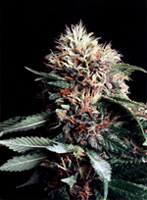Cannabis
Basics
DESCRIPTION #
Cannabis is a leafy plant which grows wild in many of the tropic and temperate areas of the world. It is cultivated both indoors and out for the production of its flowering tops. The most commonly used form of cannabis are the leaves and flowering tops (buds) which may be either smoked or eaten; It also comes in a more concentrated resinous form called hashish, and as a sticky black liquid called hash oil. There are three distinct species of cannabis: Cannabis sativa, Cannabis indica, and Cannabis ruderalis, though there is some argument as to whether these should be considered varieties rather than species. Most recreationally used cannabis is the result of interbreeding between these three types. The term 'hemp' is generally used to describe low-thc varieties of cannabis which are grown for industrial uses.
The strength of cannabis varies greatly from one variety to another. Some, known as 'one-hit-shit', requires only a single lung-full to reach full effects while other varieties require many hits to achieve the same effects. Additionally, the amount that one individual likes to smoke can be many times what another prefers. Generally, 1/8 ounce (3.5 g) of mid-quality bud could get around 20-30 people reasonably high.
Price #
Cannabis is sold on the street for anywhere between $25 - $150 per 1/4 ounce depending on quality and location. In the U.S., prices are generally $30-$60 for 1/4 ounce of lower quality and $60-$120 for 1/4 ounce of high quality bud. Prices drop quickly as quantity goes up, with prices for one pound of the lowest quality cannabis going from 0 (leaves are sometimes given away during harvest) to $200 and good quality buds from $1200 - $2000 per pound.
The legal status of cannabis is currently shifting around the world. Although the 1971 UN Convention on Psychotropic Substances prohibits cannabis and requires counties to prohibit its use and sale, individual US states and some countries have started legalizing cannabis. As of August 2015, Cannabis has been nationally legalized in Uruguay (2013) and Jamaica (2015). In contradiction of federal law (as of May 2019), ten American states have legalized the recreational use of cannabis; Alaska, Oregon, Colorado, Washington, California, Nevada, Vermont, Massachusetts, Vermont, and Rhode Island.
Prescription and quasi-prescription medical use of cannabis is increasingly legally recognized, with individual cities, states, and countries exploring approved medical use.
Prescription and quasi-prescription medical use of cannabis is increasingly legally recognized, with individual cities, states, and countries exploring approved medical use.
The active ingredients in cannabis are called cannabinoids. There are many cannabinoids synthesized by the plant including tetrahydrocannabinol, cannabinol, cannabidiol, cannabinolidic acid, cannabigerol, and cannabichromene. Delta-9-tetrahydrocannabinol is thought to be responsible for most of the psychoactive effects of cannabis and is the active ingredient in synthetic thc pills such as marinol.
Pharmacology #
Pharmacology Summary Needed.
Production #
Cannabis plants do grow wild in many parts of the world, but the quality of wild specimens ('ditch-weed') is generally quite low. Most cannabis is cultivated intentionally and can be grown either indoors or out.
The cannabis plant has been used both medicinally and recreationally for thousands of years. It wasn't until the early 19th century that the use of cannabis as a psychoactive spread from China and the Middle East to the population of Europe and then to America in the middle of the century. Cannabis was made illegal in the U.S. in 1937 and has continued to be a popular recreational substance since that time.
Terminology / Slang #
The Substance:
Cannabis; Marijuana; Marihuana; Pot; Dope; Weed; Grass; Bud; Ganja; Mary Jane; Doobie; Hashish; Hash; Bhang.
The Experience:
Stoned; High.
The primary effects sought by those using cannabis recreationally are euphoria, relaxation, and changes in perception. Effects vary depending on dosage, with effects at low doses including a sense of well-being, mild enhancement of senses (smell, taste, hearing), subtle changes in thought and expression, talkativeness, giggling, increased appreciation of music, increased appetite, and mild closed-eye visuals. At higher doses, visuals may become more prominent, sense of time is altered, attention span and memory are frequently affected, and thought processes and mental perception may be significantly altered.
Onset #
When smoked, the effects of cannabis begin almost immediately. When eaten the effects can take 1 to 2 hours to manifest, based primarily on how much food is in the stomach.
Duration #
The effects of smoked cannabis peak after about 20 minutes and last for 1-2 hours. When eaten, the effects will peak more slowly and primary effects may last for 3-4 hours.
Visual Effects #
While most people do not experience a strong visual component to the cannabis experience, some do and some particular varieties of cannabis as well as higher doses are more likely to produce this effect.
PROBLEMS #
Negative effects can include paranoia, dry mouth, respiratory problems and nervousness/racing heart. Other effects may be negative or inconvenient in certain settings or situations including reduced ability to concentrate, impaired memory, tiredness, and confusion. Side effects tend to increase with lifetime use: as users age, they often report the anxiety-producing and uncomfortable effects increase and the euphoria decreases.
Contraindications #
Avoid Driving - While there has been little formal study into the effects of cannabis on driving, it is generally a good idea to avoid driving while under the influence of any psychoactive or intoxicating substance. Several studies have shown that drivers who use alcohol and cannabis in combination are far less capable than when taking either substance alone. Some studies have shown that cannabis causes impairment in driving performance, but that users often are aware of the impairment and compensate by driving more carefully.
Addiction Potential #
Regular use of cannabis can lead to psychological habituation for some people making it difficult for them to quit. Studies have estimated that between 5 and 10% of those who try smoking cannabis will become daily users sometime during their life, but most of these smokers will have given up the habit by age 30 and few remain daily smokers after age 40. Most people do not experience signs of physical addiction, but with regular daily use, mild to medium withdrawal symptoms usually occur for less than a week, but can extend for as long as 6 weeks.
Long Term Health Problems #
The most common negative health impact of regular cannabis smoking are lung and throat problems including: coughing, increased frequency of throat and lung infections, and reduced lung capacity. There are concerns about possible long term carcinogenic (cancer causing) effects of cannabis smoking, but the results are still somewhat controversial. It can be safely said, however, that health risks increase with frequency and duration of smoking anything.
Risk of Death #
There are no confirmed, published death reports from cannabis-only poisoning. Especially given the wide use of cannabis, it appears that fatal reactions are approximately unheard of. There are a small number of people who report serious cannabis allergies which cause unexpectedly intense reactions, throat & lung irritation, etc.
Heart Issues #
Because cannabis increases heart rate, it could potentially increase risks of heart problems in those at risk of heart disease. One study found that cannabis use increased the risk of heart attack in men over 40, but its findings were weak and based on a very small number of individuals. In a large study of 65,000 individuals in California by Sidney et al in 1997, cannabis was not found to increase mortality rates among users under 50.
Mental Illness #
For those with schizophrenia, paranoia, or symptoms of psychosis, the use of cannabis, alcohol, and other recreational drugs can contribute to worsening symptoms and a decline in normal functioning. It is less clear whether cannabis causes asymptomatic--or otherwise healthy--people more than temporary paranoia and anxiety, though several major studies have documented an association between the use of cannabis by young people and later diagnosis of psychotic disorders. Those with a family history of psychotic disorders or who are otherwise predisposed to mental illness may be at increased risk of problematic mental health issues if they use cannabis.
CAUTION & DISCLAIMER #
Erowid Basics pages are summaries of data gathered from site visitors, government documents, books, websites, and other resources. We do our best to keep this information correct and up-to-date, but the field is complex and constantly changing. Information should always be verified through multiple sources.



